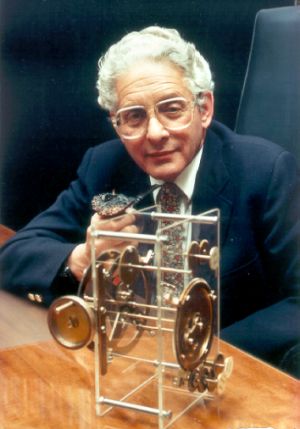Science Since Babylon
Science Since Babylon was written by Derek J. de Solla Price based on a series of five lectures he delivered at Yale University's Sterling Memorial Library in October and November 1959 on the history of science. In 1961 it was published in London and New Haven by Yale University Press, and sold as a Yale Paperbound (paperback) in 1962. It is notable due to Price's observation of the exponential trajectory of scientific growth, and his subsequent prediction of that growth leveling off due to saturation. The 1975 enlarged edition expanded on the original material and also included new material, some of which were previously published essays or sections of previously published books. The book is often cited by Eric Weinstein for its observations about growth. Weinstein also notes that it is odd how few people know about this book given the implications of its predictions for science and research.
An Open Access PDF of the book is available here.
Preface to Enlarged Edition
Preface to Original Edition
1. The Peculiarity of a Scientific Civilization
Summary
Further Reading
- Srinivasa Ramanujan
- Professor G. H. Hardy of Cambridge
- 1729
- Herbert Butterfield and The Origins of Modern Science
- Almagest by Ptolemy
- Niels Bohr's Principle of Complementarity
- Babylonian mathematics
- Greek mathematics
2. Celestial Clockwork in Greece and China
Summary
Further Reading
- Whipple Museum of the History of Science
- Astrolabe
- A Treatise on the Astrolabe by Chaucer
- Escapement
- Astrarium, a clock built by Giovanni de' Dondi in 1364
- Science and Civilisation in China, initiated and edited by Joseph Needham
- Song dynasty
- Antikythera mechanism, short documentary
3. Automata and the Origins of Mechanism and Mechanistic Philosophy
Summary
Further Reading
- Jean Froissart's L'Horloge Amouresuse and L'Horloge de Sapience
- Albertus Magnus
- St Thomas Aquinas' Summa Theological
- "beast-machine"
- Jonathan Swift's Yahoos
- Pascal's Pascaline of 1645: how it works
- musical automata of Achilles Lagenbucher of Augsburg
- waterworks of Canterbury Cathedral
- Duc Philippe, Count of Artois, castle of Hesdin, and the Garden of Earthly Delights, described in Magic and Mechanics in Medieval Fiction by Merriam Sherwood
- Polish scholar Witello
- Tower of the Winds, The Roman Agora in Athens: drone tour
- Strassbourg astronomical clock, made by Isaac and Josias Habrecht— watch it in action
- Cornelis Drebbel and his magical oven
- Cave of Lascaux: virtual tour, wiki article
4. The ✡, ⛤, and ۞, and Other Geometrical and Scientific Talismans and Symbolisms
Summary
Further Reading
- The Curious History of the Six Pointed Star by Gershom Scholem
- On the Sphere and Cylinder by Archimedes
- Chen-ning Yang
- Square root of 2 Proofs of irrationality
5. Renaissance Roots of Yankee Ingenuity
Summary
Further Reading
6. The Difference Beteween Science and Technology
Summary
Quotes
- "Do we really have to stoop so low as to lie about it again and maintain that the latest, biggest accelerator will help us make useful things? Do we need to support mathematics for the direct utility? No, not at all. We can adopt a science-for-science’s-sake policy, provided we are clear that this can always be justified by the weak but vital link with technology. We need science so that technologists may grow up immersed in it. I do not avoid the intellectual argument that we also do it because it is the most difficult and elegant thing we can do. Like Everest it is there. The question of justification only becomes important because we ask that society pay for it, and there must therefore be some sort of social contract. Some reason must exist for society to pay; in our age, if you spend on that you must go without something else. The tradition of libertas philosophandi, the freedom to follow learning wherever it may lead, is now questioned yet again in the way in which it was questioned by the ancient Romans, by the French revolutionaries, and most recently by communist Hungary. They all thought they could junk useless sciences and pay only for the useful ones. Their civilizations and states were visibly ruined by this tragic policy. It cannot be played like that. The reason is the educational process." p 131-132
- "I think that what is happening bears close analogy to the recent divorce between physics and engineering, and the gradual loss of status and salary of the engineers. Unfortunately, however, we do not clearly understand the mechanics of scientific careers and education, and we are hesitant to manipulate the technologies with all the political brutality that seems to be needed. It is a classical situation, where we need a technology of administering technology and we do not even have a decent scientific knowledge of the way that science works. I can only suggest that the most urgent need in science teaching and in planning is more intense thought and analysis, not about the facts and theories of science or the technicalities of technology, but about the place of science and technology in science, the history of these things, and also about such naive and obviously simple things as the relation between science and technology and the difference between them." p 134-135
Further Reading
7. Mutations of Science
Summary
Quotes
- "The transition from the fin de siècle state of approaching perfection of science into the turmoil of our present century is, I believe, the most interesting and also the most crucial line to follow if we wish to have an understanding of the process of modern science. If anything can, it is this that may reveal more significance than its purely local record of advances in some special area at some special time." p 142-143
- "It is a pity that it has been forgotten that the discovery of X rays became the first modern scientific break to get banner headlines in the newspapers. Its coverage exceeded that of Charles Darwin: perhaps newspapers had become more sensational in the few intervening decades. It almost rivals, too, the sort of sensation created in our own age by the first atom bomb and the manmade satellite. For weeks, running into months, there were stories, some partly true, some fantastic. The public was fascinated, often for the wrong reasons. Old ladies went into their baths fully clothed, being convinced that the scientists now had mystery rays that could look through brick walls and round corners. From this new mythology of science were born all the wonderful tales of death rays and other science-fictional flights of fantasy, vintage Jules Verne." p 148-149
- "With the consequent increase in perplexity, more scientists abroad tried the experiments, some of them spending much time and ingenuity in trying to get an effect. Some few in countries other than France were indeed successful, but for every one of these there were a dozen men of high repute who became convinced that something was very rotten in the state of French physics." p 155
- "The curious error of N rays is much more a sort of mass hallucination, proceeding from an entirely reasonable beginning. By no means can it be considered as any sort of hoax or crank delusion— it was a genuine error. It mushroomed into a complex that could have been possible only in that short and glorious epoch when physics had suddenly found the first great massive breakthrough in its modern history. Out of that arose the whole science of radioactivity, of atomic physics, and eventually all the material of particle physics." p 159
- "One may say, however, that the first atomic explosion in history was not in 1945: it took place exactly half a century earlier. And in 1895 it was not some mere laboriously built artifact of science that exploded but rather the science itself. Our modern world is largely the result of efforts to piece together the fragments left by that traumatic and crucial explosion." p 160
Further Reading
- Antoine Lavoisier
- Joseph Priestley
- Friedrich Wöhler
- Phlogiston theory
- The History Of The Phlogiston Theory by John Henry White
- James Clerk Maxwell
- Fin de siècle
- J. J. Thomson
- Cavendish Laboratory
- William Crookes
- Wilhelm Röntgen
- Henri Becquerel
- X-ray
- N ray
- Prosper-René Blondlot
- Nancy-Université
- Heinrich Rubens
- Robert W. Wood
8. Diseases of Science
Summary
Quotes
- "The most remarkable conclusion obtained from the data just considered is that the number of journals has grown exponentially rather than linearly. Instead of there being just so many new periodicals per year, the number has doubled every so many years. The constant involved is actually about fifteen years for a doubling, corresponding to a power of ten in fifty years and a factor of one thousand in a century and a half. In the three hundred years which separate us from the mid-seventeenth century, this represents a factor of one million.
- "One can be reasonably surprised that any accurate law holds over such a large factor of increase. Indeed, it is within the common experience that the law of exponential growth is too spectacular to be obeyed for very long. Large factors usually introduce some more-than-quantitative change that alters the process." p 169
- "Why should it be that journals appear to breed more journals at a rate proportional to their population at any one time instead of at any particular constant rate?" p 169
- "Thus, at any one time, about three doubling periods’ worth of scientists are alive. Hence, some 8o to go per cent of all scientists that have ever been, are alive now. We might miss Newton and Aristotle, but happily most of the contributors are with us still!" p 176
- "Science in America is growing so as to double in only ten years— it multiplies by eight in each successive doubling of all nonscientific things in our civilization. If you care to regard it this way, the density of science in our culture is quadrupling during each generation.
- "Alternatively, one can say that science has been growing so rapidly that all else, by comparison, has been almost stationary." p 177
- "It is indeed apparent that the process to which we have become accustomed during the past few centuries is not a permanent feature of our world. A process of growth so much more vigorous than any population explosion or economic inflation cannot continue indefinitely but must lead to an intrinsically larger catastrophe than either of these patently apparent dangers." p 182
- "To go beyond the bounds of absurdity, another couple of centuries of “normal” growth of science would give us dozens of scientists per man, woman, child, and dog of the world population." p 182
- "We must not expect such growth to continue, and we must not waste time and energy in seeking too many palliatives for an incurable process. In particular, it cannot be worth while sacrificing all else that humanity holds dear in order to allow science to grow unchecked for only one or two more doubling periods." p 186
Further Reading
9. Epilogue: Humanities of Science
Summary
References
- Technology And The Academics by Sir Eric Ashby
- Teacher in America by Jacques Barzun
- Essays on the History of Science by Herbert Butterfield
- The History of Science and the New Humanism by George Sarton


